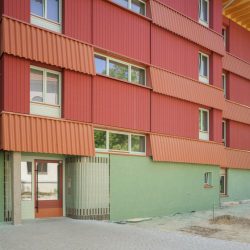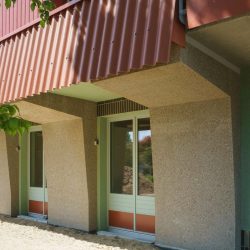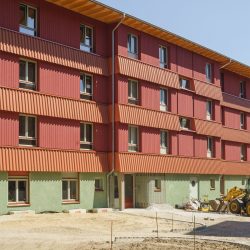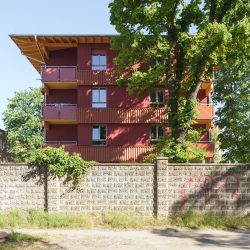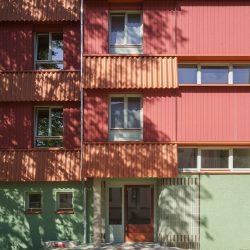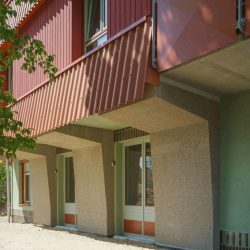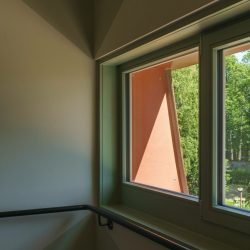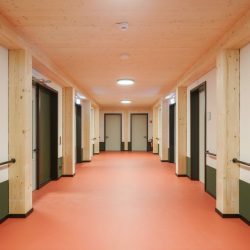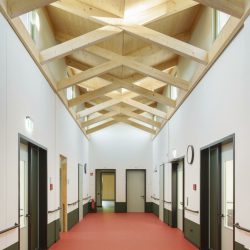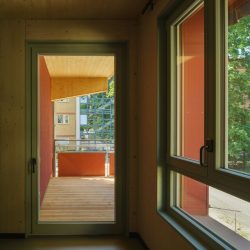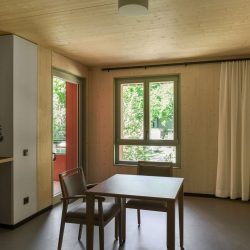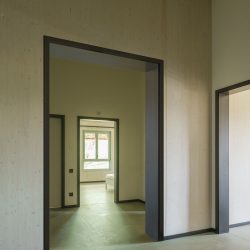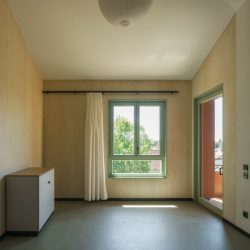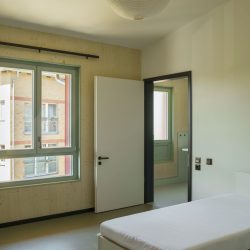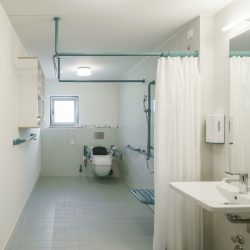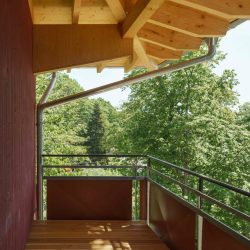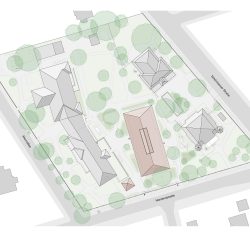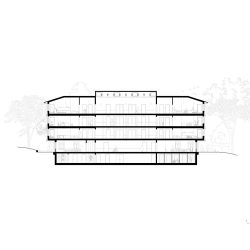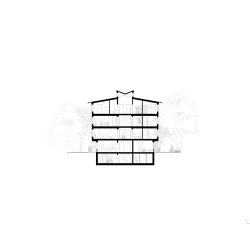
Modersohn & Freiesleben . photos: © Sebastian Schels . + baunetz
On a park-like plot in Pankow, between listed turn-of-the-century villas, a sober and functional extension from the 1990s and large old trees that have accompanied the history of this historic site, there is an ideal location for another new SKF dormitory.
Four storeys, crowned by a cantilevered roof whose wooden rafters remain visible on the outside, a solid green plastered base and a wooden superstructure will be the new home for up to 32 residents with mental and physical disabilities.
Self-determined living, supervised and assisted if necessary, each resident will have their own room and bathroom, and two of these units will have a kitchen and their own balcony. The additional need for special rooms is regulated in the German Participatory Living Act: Snoezel room, communal room with kitchen, care bathrooms, administration area and a wide range of ancillary rooms, all of which are distributed across the residential floors.
The house extends lengthways from north to south. It is 37 metres long and 16 or 14 metres wide. With its narrow side and proportions, it fits well between the villa and the house next door.
One entrance for the residents is located in the centre, accessed from the east, while another entrance for the daytime activity area is located in the centre to the west.
The two separate entrances serve the purpose of equalisation and are important for orientation; the two areas are operated and financed by different facilities, the area on the ground floor is only to be used during the day.
The address for the house is to the south, Nordendstraße, where there are also two gates in the open old wall. If you walk up the wheelchair-accessible paths, you approach the green, roughcast plinth, protected by the roof. Cut into a protrusion, the exterior dress becomes haptic here: shiny green tiles emphasise the entrance. Not only the entrance areas, but the entire ground floor is stone, solid, a solid base. Terrazzo tiles on the floor and a green and white pattern on the walls welcome users inside. And then you enter the central hallway: an open distribution room, the centre, the heart of the house, generous space instead of a narrow corridor. On the top floor, the hallway receives additional light, made possible by a special construction of intersecting rafters, where the sky becomes visible.
Like the roof, the upper storeys are also built from wood, load-bearing walls and ceilings from solid glulam, large elements, thickly packed in mineral insulation, weather-protected, clad in red glazed boards, rough sawn. The elements arrived in Berlin from Lower Saxony prefabricated, including windows and panelling. Only the protective skirts were installed on site; they cover the joints, absorb the sun protection and will delay the ageing of the wood. The skirts are made of corrugated cement and their sheet metal end acts as a fire protection bar.
All the materials used are certified, finished industrial products. The red of the wood, the sheet metal and the corrugated sheets are standardised, as are the dimensions. No customisation should delay or increase the cost of construction.
Two stairwells guarantee optimum safety in an emergency. The entire house is barrier-free and wheelchair accessible. The greatest attention was also paid to all the necessary requirements in terms of design: Wheelchair waiting areas in the stairwells, clear heights in the windows, high-contrast light switches and handles, handrails in the public areas, maximised glass cut-outs, push-buttons and emergency call systems throughout the building.
The energy supply is provided by geothermal probes, PV systems supply electricity. The house is completely energy self-sufficient.
When the day guest is collected at the end of the day, a pavilion offers protection from the rain and sun. Its four pillars are the same as those that support the projections and recesses of the house on the ground floor.
And so the pavilion and the house complete the small ensemble in the park.
_


